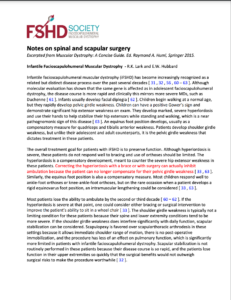 Excessive curvature of the lower spine, a condition called hyperlordosis, can be a particularly painful and troublesome symptom of FSH muscular dystrophy. We are often asked whether abdominal braces or surgery can help. To answer this question, Dr. Ray Huml has kindly given us permission to share an excerpt by Drs. R.K. Lark and E.W. Hubbard from his 2015 book on Muscular Dystrophy, which we have added to our Library. You can download it here.
Excessive curvature of the lower spine, a condition called hyperlordosis, can be a particularly painful and troublesome symptom of FSH muscular dystrophy. We are often asked whether abdominal braces or surgery can help. To answer this question, Dr. Ray Huml has kindly given us permission to share an excerpt by Drs. R.K. Lark and E.W. Hubbard from his 2015 book on Muscular Dystrophy, which we have added to our Library. You can download it here.
Hyperlordosis is more common in individuals who manifest symptoms from an early age. Drs. Lark and Hubbard note that people with early-onset FSHD can develop rapid weakening of the hip girdle muscles. It is this hip girdle weakness, rather than core muscle weakness, that leads to the exaggerated spinal curvature as the individual tries to maintain his or her center of gravity. “The hyperlordosis is a compensatory development, meant to counter the severe hip extensor weakness in these patients,” they write. “Correcting the hyperlordosis with a brace or with surgery can actually inhibit ambulation because the patient can no longer compensate for their pelvic girdle weakness.” Early onset individuals may need a wheelchair by their second or third decade. In such cases, “one could consider either bracing or surgical intervention to improve the patient’s ability to sit in a wheel chair,” the authors write.
Drs. Lark and Hubbard also comment on when to consider surgery to correct winging of the shoulder blades, or scapula. Surgery to attach the scapula can restore the range of arm movement. “Scapulopexy is favored over scapulorthoracic arthrodesis in these settings because it allows immediate shoulder range of motion, there is no post-operative immobilization, and the procedure has less of an effect on pulmonary function,” they write. But they caution that in individuals with rapidly progressing upper extremity weakness, scapular stabilization is not routinely performed because “the patients lose function in their upper extremities so quickly that the surgical benefits would not outweigh surgical risks to make the procedure worthwhile.”
Check out the following FSHD Society webinars for more information:


Leave a Reply